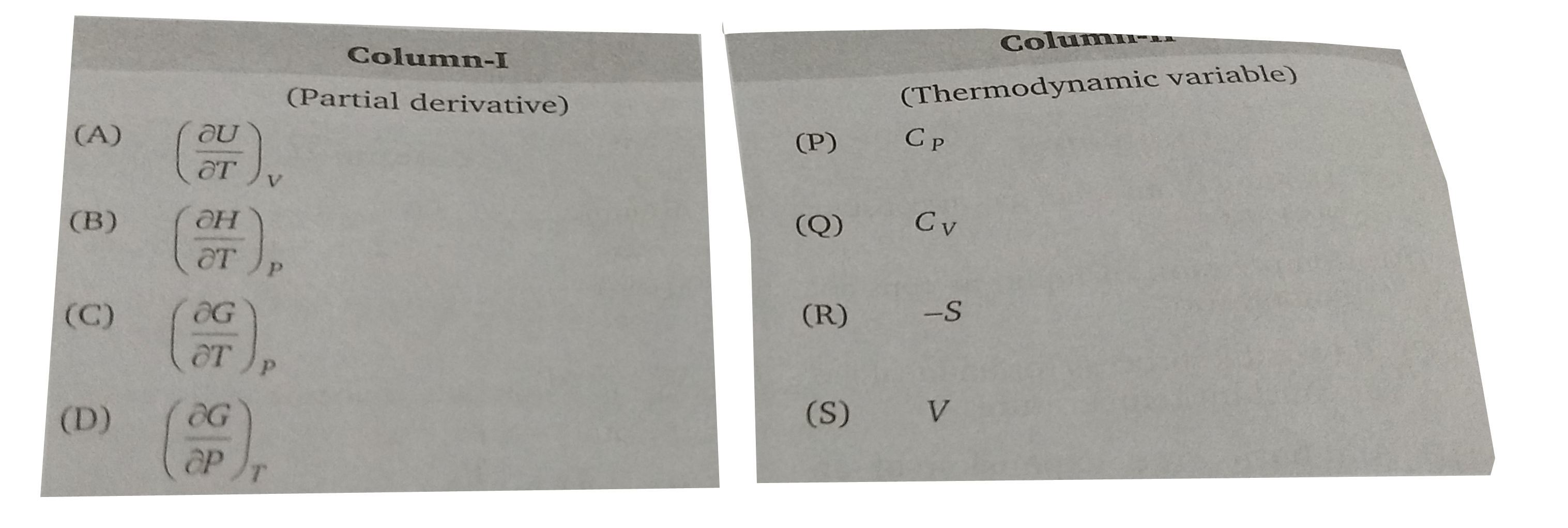Which of the following conditions will always lead to a non-spontaneous change ? Solution in Punjabi
ΔH and ΔS both +ve
ΔH=−ve,ΔS=+ve
ΔH=+ve,ΔS=−ve
ΔH=−ve,ΔS=−ve
The correct Answer is:A, C, D
ΔG=ΔH−TΔS
(a)ΔH=+ve,ΔS=+ve at low temperature ΔG=+ve
(b) ΔH=−ve,ΔS=+ve,ΔG=−ve
at any temperature.
(c)ΔH=+ve,ΔS=−ve,ΔG=+ve at any temperature
(d) ΔH=−ve,ΔS=−ve,ΔG=+ve at high temperature
Topper's Solved these Questions
- BOOK - NARENDRA AWASTHICHAPTER - THERMODYNAMICSEXERCISE - Level 3 - One Or More Answers Are Correct1videos
THERMODYNAMICS
- BOOK - NARENDRA AWASTHICHAPTER - THERMODYNAMICSEXERCISE - Level 3 - Match The Column2videos
THERMODYNAMICS
- BOOK - NARENDRA AWASTHICHAPTER - THERMODYNAMICSEXERCISE - Level 2 (Q.1 To Q.30)1videos
THERMODYNAMICS
- BOOK - NARENDRA AWASTHICHAPTER - STOICHIOMETRYEXERCISE - Level 3 - Subjective Problems20videos
STOICHIOMETRY
Similar Questions
Assume ideal gas behaviour for all the gases considered and neglect vibrational degrees of freedom. Separate equimolar sample. Separate equimolar samples of Ne, O2 , CO2 and SO2 were subjected to a two process as mentioned. Initially all are at same state of temperature and pressue.
Step I → All undergo reversible adiabatic expansion to attain same final volume, which is double the original volume thereby causing the decreases in their temperature.
Step → After step I all are given appropriate amount of heat isochorically to restore the original temperature.
Mark the correct option(s) :03:35View SolutionMatch the following columns
 02:52View Solution
02:52View SolutionWrite structure of 2,2-dimethylheptane.
02:13View SolutionWhat volume of a liquid (in L) will contain 10 mole ? If molar mass of liquid is 280 and its density is 1.4 g/mL.
02:57View SolutionWhich of the following conditions leads to a spontaneous process at all temperature
02:57View SolutionWhich of the following sets of conditions would result in a reaction that is spontaneous at high temperature but non-spontaneous at low temperature?
07:29View SolutionWhich of the following Process is non-spontaneous
View SolutionWhich of the following conditions may lead to a non-spontaneous change?
03:11View SolutionWhich of the following conditions may lead to a non-spontaneous change?
View Solutionएक स्वतः प्रवर्तित प्रक्रम सदैव साम्य की और अग्रसर होता है ।
02:03View SolutionWhich of the following is non-spontaneous process?
02:18View SolutionWhat are spontaneous and non-spontaneous changes?
02:21View SolutionWhich of the following conditions will always lead to a non-spontaneous change?
02:32View SolutionWhich of the following is the condition for a non spontaneous reaction at high temperature but spontaneous at low temperature ?
04:14View SolutionWhich of the following conditions may lead to a non-spontaneous change?
03:33View SolutionWhich of the following conditions may lead to a non-spontaneous change?
a.ΔH and ΔS both +ve
b.ΔH=−ve,ΔS=+ve
c.ΔH=+ve,ΔS=−ve
d.ΔH=−ve,ΔS=−ve01:38View Solution

